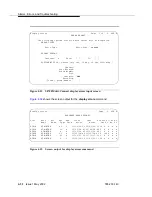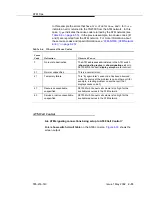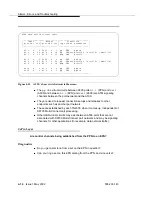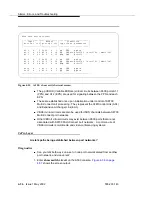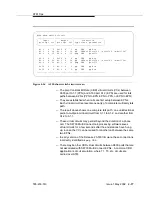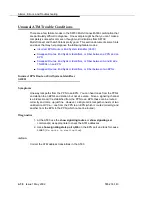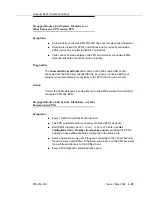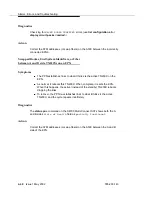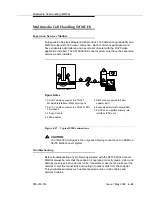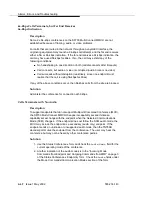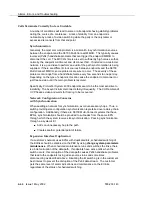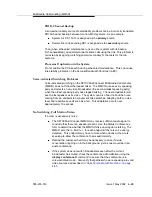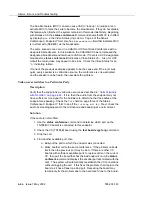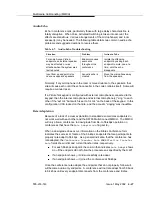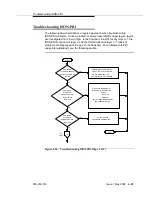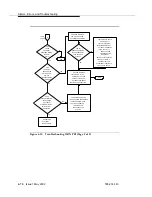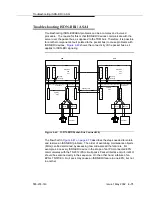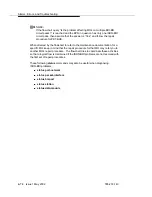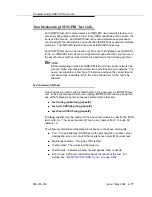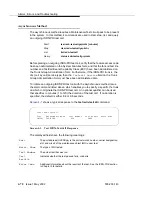
Alarms, Errors, and Troubleshooting
555-233-143
4-66
Issue 1 May 2002
The See-Me feature (MCV) can also cause VAS to “lock-up.” An endpoint can
activate MCV to force their site to become the broadcaster. If they do not disable
the feature when finished, the system remains in this mode indefinitely. Beginning
with Release 3.0, the status conference X command shows that MCV is in effect
by displaying
av
in the Video Status (Vs) column. Page 3 of the Status
Conference X Endpoint Y form also has a
Broadcaster
field that indicates MCV
is in effect with (SEE-ME) as the broadcaster.
The same scenario can occur in a CHAIR or UCC-controlled conference with a
designated broadcaster. In this situation, the CHAIR/UCC has not released the
designated broadcaster and returned to VAS mode. If there is a UCC-designated
broadcaster, status conference X indicates a Video Status of
u
. Also, for UCC
rollcall the return video may appear to be stuck. Check the Video Status for an
“
R
,” indicating rollcall.
If none of the previous examples appears to be the cause and if the room was
quiet, every speaker is a valid video source, the conference is voice-activated,
and the speaker can be heard, then escalate the problem.
Video never switches to a Particular Party
Description
Verify that the endpoint is a valid video source as described in
. If it is, then the audio from the endpoint may not
have sufficient voice signal for the hardware to determine that the parties at the
endpoint are speaking. Check the
Talk
field on page three of the Status
Conference X Endpoint Y form to see if the
talking bit
is
y
. Next, check the
audio by standing adjacent to the microphone and speaking at a normal level.
Solution
If the audio is not muffled:
1. Use the status conference command to determine which port on the
TN788B (VC board) is connected to this endpoint.
2. Check the VC (TN788B) board using the test board xxyy long command.
3. Drop the call.
4. Find another available port, then:
a. Busyout the port to which the endpoint was connected.
b. Make another call to the same conference. If the problem corrects
itself, then the previous port may be bad. If there are other VC
boards with sufficient available ports to replace calls on the current
VC, then pull the board that has the bad endpoint on it (the status
conference command displays the encoder port associated with the
call). The system will automatically reestablish the VC connections
without dropping the call. If this fixes the problem, then replace the
board, as it has at least one bad port. Reseating the board may
temporarily fix the problem due to the hard reset done to the board.
Summary of Contents for S8700 Series
Page 50: ...Maintenance Architecture 555 233 143 1 26 Issue 1 May 2002 ...
Page 74: ...Initialization and Recovery 555 233 143 3 12 Issue 1 May 2002 ...
Page 186: ...Alarms Errors and Troubleshooting 555 233 143 4 112 Issue 1 May 2002 ...
Page 232: ...Additional Maintenance Procedures 555 233 143 5 46 Issue 1 May 2002 ...
Page 635: ...status psa Issue 1 May 2002 7 379 555 233 143 status psa See status tti on page 7 406 ...
Page 722: ...Maintenance Commands 555 233 143 7 466 Issue 1 May 2002 ...

